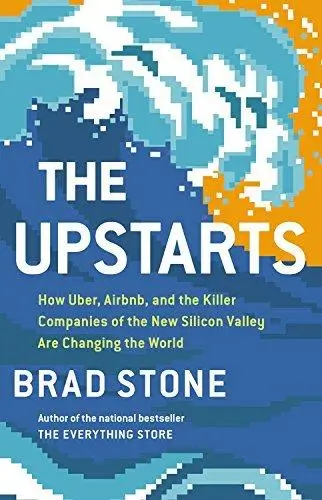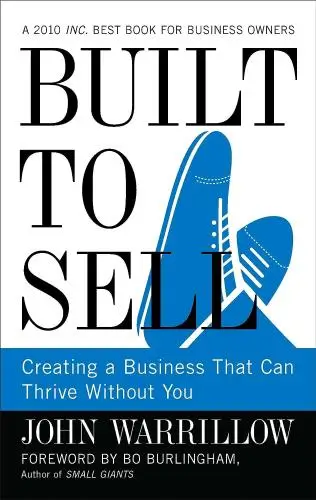
Sam Walton
Made In America
What's it about?
"Sam Walton: Made In America" is an inspiring autobiography that takes you inside the mind of the retail giant who founded Walmart. Written by Sam Walton himself, this book is a deep dive into his relentless pursuit of excellence, innovative strategies, and the humble beginnings of what would become a global empire. Walton shares invaluable business insights, personal anecdotes, and the core principles that guided his journey from a single dime store to leading the world's largest retail chain. A must-read for entrepreneurs, this memoir is a masterclass in building a business from the ground up with passion, hard work, and an unwavering belief in one's dreams.
About the Author
Sam Walton was the American entrepreneur and founder of Walmart and Sam's Club, two of the world's largest retail chains. Known for his innovative retail strategies and commitment to low prices, Walton's approach revolutionized the retail industry, emphasizing efficiency, bulk purchasing, and passing savings onto consumers. His autobiography, "Made in America," details his journey and business philosophy.
10 Key Ideas of Sam Walton
Embrace a Frugality Mindset to Fuel Business Growth
Adopting a frugal approach in business operations can significantly contribute to minimizing costs and maximizing profits.
This involves scrutinizing every expense, no matter how small, to ensure it is absolutely necessary and contributes directly to the growth or efficiency of the business.
By saving on costs where possible, without compromising the quality of products or services offered, a business can reinvest the savings into areas that promote growth such as expansion, marketing, or research and development.
This mindset also fosters an organizational culture of resourcefulness and innovation, as employees are encouraged to find cost-effective solutions to problems.
Learn DeeperReview Regular Expenses: Take a close look at your recurring business expenses. Identify areas where you might be able to cut costs without affecting the quality of your product or service. This could mean negotiating better rates with suppliers, switching to more cost-effective service providers, or even cutting unnecessary subscriptions.
Implement a Budget for Projects and Purchases: Before making any significant business purchase or starting a new project, create a detailed budget. This should include a cost-benefit analysis to ensure that the investment will contribute to your business's growth or efficiency. Stick to this budget as closely as possible.
Encourage a Culture of Cost-Consciousness: Foster an environment where employees are encouraged to think about cost-saving measures in their daily tasks and projects. Recognize and reward innovative ideas that save the company money while maintaining quality and efficiency.
Regularly Audit Operations for Efficiency: Periodically review your business operations to identify inefficiencies or areas where resources may be wasted. Look for processes that can be streamlined or tasks that can be automated to save time and money.
- Example
A small retail business negotiates with its suppliers to get bulk purchase discounts, reducing the cost of goods sold. They also switch to energy-efficient lighting to lower utility bills, directly impacting their bottom line without compromising customer experience.
- Example
A tech startup implements a policy where all software purchases or subscriptions must be approved by a committee. This ensures that only essential tools are paid for, and alternatives are considered, such as open-source software, which can significantly reduce operational costs.
Cultivate Strong Relationships with Suppliers for Mutual Benefit
Building and maintaining robust relationships with suppliers can lead to more favorable terms, discounts, and access to new products before competitors.
This requires regular communication, fair negotiations, and a commitment to mutual success.
By treating suppliers as partners rather than mere vendors, businesses can secure better deals, which can then be passed on to customers in the form of lower prices or higher quality goods.
Additionally, strong supplier relationships ensure a reliable supply chain, reducing the risk of stockouts and enabling faster response times to market changes.
Learn DeeperRegularly Schedule Meetings with Your Suppliers: Make it a point to have frequent, scheduled discussions with your suppliers. This could be monthly or quarterly, depending on your business needs. Use these meetings to discuss performance, upcoming needs, and potential challenges. It's also a great opportunity to explore new products or services they might offer.
Negotiate with a Win-Win Mindset: Approach negotiations by looking for terms that benefit both parties. Instead of squeezing your suppliers for the lowest possible price, consider how you can work together to achieve mutual benefits, such as longer payment terms, bulk purchase discounts, or exclusive access to new products.
Share Your Business Plans and Forecasts: By sharing your business plans and sales forecasts with your suppliers, you help them better understand your business and its needs. This transparency can lead to them offering you better deals or prioritizing your orders during peak times.
Develop a Supplier Recognition Program: Recognize and reward your top suppliers. This could be through an annual award, public recognition, or simply by providing them with more business. Acknowledging their importance to your business strengthens the relationship and encourages continued excellent service.
- Example
A small retail clothing store owner regularly meets with their fabric suppliers to discuss upcoming seasonal trends. Together, they negotiate prices and delivery schedules that allow the store to offer competitive pricing to its customers while ensuring the supplier has steady orders throughout the year.
- Example
A local restaurant owner shares their projected customer growth and menu expansions with their food suppliers. In return, the suppliers offer the restaurant first access to new, high-quality ingredients and flexible payment terms, helping the restaurant maintain its reputation for fresh, innovative dishes.
Implement a Customer-First Philosophy Across All Operations
Prioritizing customer satisfaction above all else ensures long-term business success.
This philosophy should permeate every aspect of the business, from product selection and pricing to employee training and customer service.
Understanding and anticipating customer needs, and then meeting or exceeding those expectations, builds loyalty and encourages repeat business.
Furthermore, happy customers are more likely to refer others, effectively acting as free marketing agents.
Regularly soliciting and acting on customer feedback also helps in continuously improving the shopping experience.
Learn DeeperListen Actively to Your Customers: Make it a habit to ask for feedback through surveys, social media, or direct conversations. Pay attention not just to what they say, but also to what they might not be saying directly. This can help you anticipate their needs.
Train Your Team in Customer Service Excellence: Ensure every member of your team understands the importance of putting the customer first. Regular training sessions on empathy, problem-solving, and effective communication can make a big difference.
Implement a Feedback Loop: Once you receive customer feedback, act on it. If you make changes based on customer suggestions, let them know. This shows that you value their input and are committed to improving their experience.
Create a Customer Loyalty Program: Reward repeat customers with discounts, special offers, or early access to new products. This not only encourages them to keep coming back but also makes them feel valued.
Personalize the Customer Experience: Use customer data (responsibly) to tailor your offerings and communications. Personalized recommendations or greetings can enhance the shopping experience and build a stronger connection.
- Example
A local coffee shop introduces a suggestion box and actively encourages customers to leave feedback. They regularly review the suggestions during staff meetings and implement changes based on customer input, such as introducing oat milk as an alternative.
- Example
An online retailer uses customer purchase history to send personalized email recommendations for new products. They also implement a loyalty program where customers earn points for each purchase, which can be redeemed for discounts on future orders.
Foster an Open Communication Culture Within the Organization
Encouraging open and honest communication among all levels of an organization promotes a sense of belonging and team spirit.
It allows for the free flow of ideas, feedback, and concerns, leading to more innovative solutions and quicker problem-solving.
Employees who feel heard and valued are more engaged, motivated, and productive.
Moreover, transparency in communication builds trust, which is crucial for maintaining morale during challenging times and for implementing changes within the company.
Learn DeeperCreate a 'No Door' Policy: Encourage managers and team leaders to maintain an open-door policy, or better yet, a 'no door' policy where possible. This means anyone in the organization can approach leadership with ideas, concerns, or feedback without fear of reprisal or dismissal.
Implement Regular Feedback Sessions: Schedule regular one-on-one check-ins between employees and their direct supervisors, as well as team meetings where open discussion is encouraged. Use these sessions not just for updates on projects, but to solicit feedback, ideas, and concerns from team members.
Utilize Anonymous Feedback Tools: Introduce tools or platforms where employees can provide anonymous feedback. This can be particularly effective for gathering honest insights and concerns that employees may be hesitant to voice openly.
Foster a Culture of Recognition: Make it a habit to publicly acknowledge and celebrate contributions and achievements of team members. This not only boosts morale but also encourages others to share their ideas and feedback, knowing that their contributions are valued.
Train Leaders in Effective Communication: Invest in training for managers and team leaders to improve their communication skills, particularly in active listening and providing constructive feedback. Effective communication from the top down sets the tone for the entire organization.
- Example
A tech startup implements a monthly 'Town Hall' meeting where employees at all levels are encouraged to speak up about any topic, from operational challenges to new product ideas. The CEO leads the session, emphasizing that every voice is valuable and every concern is worth addressing.
- Example
A retail company introduces an internal platform where employees can submit ideas for improving customer service anonymously. Each quarter, the best ideas are implemented, and the contributors are recognized and rewarded, even if their contributions were anonymous.
Continuously Seek Innovation and Adaptability
In a rapidly changing market, the ability to innovate and adapt is key to staying competitive.
This means being open to new technologies, business models, and market trends.
Encouraging a culture of experimentation and not fearing failure allows for learning and growth.
Businesses should constantly look for ways to improve their products, services, and processes to meet evolving customer needs and to gain an edge over competitors.
Staying adaptable also involves being ready to pivot strategies when certain approaches do not yield the expected results.
Learn DeeperStay Informed: Regularly read industry news, attend workshops, and participate in relevant online forums. This keeps you updated on the latest trends and technologies that could impact your field.
Foster a Culture of Innovation: Encourage your team to share new ideas without fear of failure. Set aside time for brainstorming sessions and consider implementing an 'idea box' where employees can submit suggestions anonymously.
Experiment Often: Allocate resources for testing new strategies or products on a small scale before full implementation. Learn from both successes and failures to refine your approach.
Adapt Quickly: Be prepared to pivot your strategies if they're not meeting expectations. This might mean abandoning a project that's no longer viable or rapidly adopting a new technology to stay ahead.
Solicit Feedback: Regularly ask for feedback from customers and employees. This can provide valuable insights into areas for improvement and new opportunities to explore.
- Example
A retail company noticing a trend in online shopping decides to allocate more resources to develop their e-commerce platform. They start with a pilot project to test the waters before fully committing.
- Example
A software development firm adopts a policy of dedicating Fridays to personal projects and innovation. Employees are encouraged to work on anything they're passionate about, leading to the development of new features and products.
Deeper knowledge. Personal growth. Unlocked.
Unlock this book's key ideas and 15M+ more. Learn with quick, impactful summaries.
Read Full SummarySign up and read for free!
Sam Walton Summary: Common Questions
Experience Personalized Book Summaries, Today!
Discover a new way to gain knowledge, and save time.
Sign up for our 7-day trial now.
No Credit Card Needed

Similar Books

$100M Offers
Alex Hormozi
Principles of Marketing, Global Edition
Gary Armstrong
The 100 Best Business Books of All Time
Jack Covert
Playing to Win
A.G. Lafley
Productize
Eisha Armstrong
Start Your Own Pet-Sitting Business and More
Entrepreneur Press
The 22 Immutable Laws of Marketing
Al Ries
The Upstarts
Brad Stone
Lean Analytics
Alistair Croll
Built to Sell
John WarrillowTrending Summaries

Peak
Anders Ericsson
Never Split the Difference
Chris Voss
Smart Brevity
Jim VandeHei
The Psychology of Money
Morgan Housel
The First 90 Days
Michael D. Watkins
Atomic Habits
James Clear
Thinking, Fast and Slow
Daniel Kahneman
The Body Keeps the Score
Bessel van der Kolk M.D.
The Power of Regret
Daniel H. Pink
The Compound Effect
Darren HardyNew Books

Job Interviews For Dummies®
Joyce Lain Kennedy
Job Interviews In A Week
Alison Straw
Handbook of Career Development
Gideon Arulmani
The Art of Spending Money
Morgan Housel
$100M Offers
Alex Hormozi
A Candle for Kiri
Edna Mae Holm
Principles of Marketing, Global Edition
Gary Armstrong
Serpent Rising: The Kundalini Compendium
Neven Paar
Feeling Is the Secret
Neville Goddard
